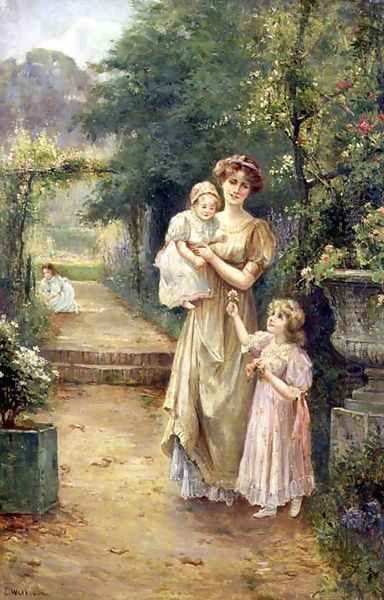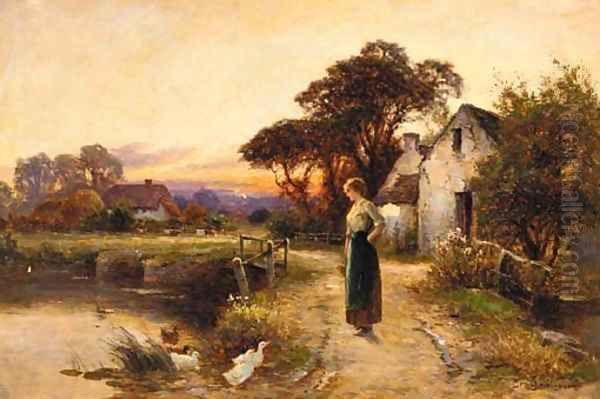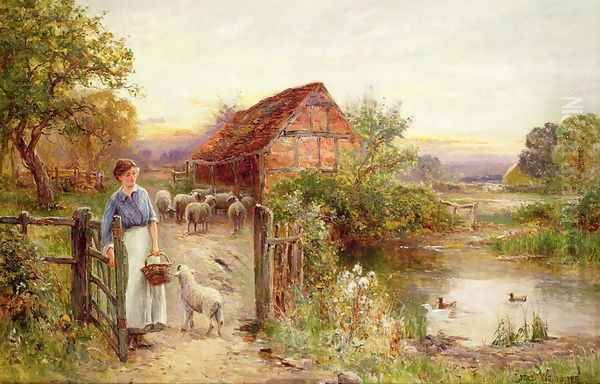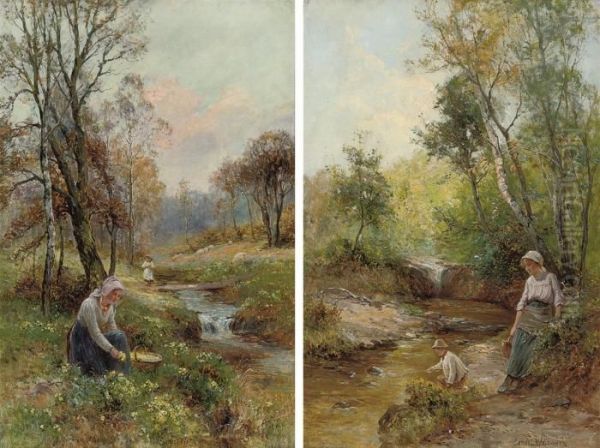Ernest Charles Walbourn stands as a significant figure in the tradition of British landscape painting, particularly cherished for his romantic and idealized depictions of the English countryside during the late Victorian and Edwardian periods. His work captures a sense of peace, nostalgia, and gentle beauty, offering viewers a glimpse into a serene, sun-dappled world far removed from the industrial realities of his time. As an artist adept in both oil and watercolour, Walbourn masterfully rendered the interplay of light and shadow, bringing life to pastoral scenes populated by charming figures, rustic cottages, and flourishing nature.
Early Life and Artistic Awakening
Ernest Charles Walbourn was born in Dalston, London, on February 16, 1872. He was the second of five children. His early life presented a potential divergence from his eventual artistic path. His father initially held aspirations for young Ernest to pursue a career in architecture, a respectable and practical profession. However, the pull towards art proved strong for Walbourn.
Fortunately, his father did not remain rigidly fixed on his initial hopes. Recognizing his son's genuine passion and talent for painting, he eventually offered his support. This paternal encouragement was crucial, providing Walbourn with the foundation and confidence needed to dedicate himself fully to art. As part of this support, his father even facilitated the establishment of a studio for him, a significant step for any aspiring artist.
A pivotal moment in Walbourn's development came with his move away from the bustling metropolis of London. He settled in Chingford, located in the county of Essex. This relocation immersed him in the very landscapes that would become the heart and soul of his artistic output – the gentle fields, woodlands, and rural settings of the English countryside. This environment provided endless inspiration and subject matter for his developing artistic vision.
Development of a Romantic Style

Walbourn's artistic style is firmly rooted in the romantic tradition, yet it incorporates a keen observation that lends a sense of realism to his idealized scenes. He became particularly known for his ability to capture the effects of light, especially sunlight filtering through trees or illuminating figures within the landscape. This focus on light and shadow, often rendered with a soft, atmospheric quality, became a hallmark of his work.
He primarily worked in oils, which allowed for rich colours and detailed rendering, but he was also proficient in watercolours, often used for capturing more fleeting effects of light and atmosphere. His paintings typically depict scenes of rural life – farmers at work, women tending to animals, children playing near streams, or simply figures resting within picturesque settings. These scenes are invariably peaceful and harmonious, emphasizing a symbiotic relationship between humanity and nature.
Walbourn's vision of the countryside was distinctly idyllic. While based on real locations and observations, his paintings often present a romanticized view of rural existence. They evoke a sense of timelessness and tranquility, celebrating the simple beauties of nature and traditional country life. This approach resonated strongly with audiences of the time, who often sought refuge from the complexities and rapid changes of modern industrial society in such gentle, reassuring imagery. His figures, often young women or children, possess an innocence and grace that further enhances the pastoral charm of his compositions.
Key Works and Recurring Themes
While a definitive list of all his major works is extensive, several titles consistently appear as representative of Ernest Walbourn's oeuvre, showcasing his typical subjects and stylistic concerns. These paintings often feature descriptive titles that clearly indicate their content, inviting the viewer into the specific moment captured.
Among his well-known works are paintings like Girl at the Mill Wheel, Children's Joy, Woman and Geese, Sunset, One for Baby, Feeding Time, and Landscape with Cottage and Woman. These titles highlight his focus on everyday rural activities and the integration of figures, particularly women and children, within the landscape. The presence of animals, such as geese or sheep in Bringing Home the Sheep, is also a common feature, adding to the bucolic atmosphere.

Other notable titles include Friendly Greetings, The Flower Picker, Woman Feeding Birds, and Girl by the Stream. These works often emphasize moments of quiet interaction or contemplation within nature. Bluebell Wood is indicative of his specific interest in capturing the beauty of English woodlands during particular seasons, showcasing his skill in rendering foliage and the dappled light filtering through the canopy. The recurring themes are clear: the beauty of the cultivated and wild English landscape, the gentle rhythms of rural labour and leisure, and the innocent charm of country folk, all bathed in his characteristic warm light.
Collaboration with Eva Knight
An interesting and significant aspect of Ernest Walbourn's life and career was his artistic partnership with his wife, Eva Knight. They married in 1906, and Eva became not only his life partner but also a frequent model for the figures that populate his idyllic landscapes. Her presence in his paintings adds a personal dimension to his work, embodying the graceful femininity often associated with his style.
However, Eva Knight's role extended beyond simply posing for her husband. She was an artist in her own right, developing skills as a landscape painter. Crucially, she actively collaborated with Ernest on his larger canvases. It is documented that Eva often took responsibility for painting the background elements in many of his significant works. This collaboration allowed Ernest to focus on the figures and perhaps the more intricate details or light effects, while Eva's contribution ensured the completion of the overall composition.
This working relationship highlights a mutual respect and shared artistic sensibility. Eva Knight eventually gained recognition for her own artistic merits, moving beyond the role of assistant to become an acknowledged amateur landscape painter herself. Their partnership underscores the supportive environment that likely contributed to Walbourn's prolific output and consistent quality.
Exhibitions and Recognition
Ernest Walbourn achieved considerable success and recognition during his lifetime. His appealing style and subject matter found favour with the art establishment and the public alike. He began exhibiting his work relatively early in his career, gaining exposure through important London institutions.
His presence was notably felt at the Royal Institute of Oil Painters, where he exhibited regularly and began to build his reputation. He also submitted works to the prestigious Royal Academy of Arts, the benchmark for artistic success in Britain at the time. Furthermore, his paintings were shown at the Royal Society of British Artists, indicating a broad acceptance within the mainstream art world.

Beyond these institutional exhibitions, Walbourn's work proved commercially popular. Many of his paintings were sold through prominent London galleries, including a notable relationship with the firm W. Samson & Co. (sometimes referred to as Samson & Walpole or similar variations in records). These galleries played a crucial role in connecting artists like Walbourn with collectors, ensuring his work reached a wide audience and provided him with a sustainable income. The consistent demand for his paintings throughout his career attests to their widespread appeal.
Artistic Context: Victorian and Edwardian Landscape Painting
To fully appreciate Ernest Walbourn's contribution, it's helpful to place him within the broader context of British art during the late 19th and early 20th centuries. Landscape painting had a long and revered history in Britain, reaching towering heights with masters like John Constable, whose naturalistic depictions of Suffolk profoundly influenced the genre, and J.M.W. Turner, renowned for his dramatic and atmospheric renderings of light and nature.
By Walbourn's time, landscape and rural genre scenes remained immensely popular, catering to a public often nostalgic for a perceived simpler, pre-industrial past. Walbourn operated within this popular tradition, alongside numerous contemporaries who explored similar themes, albeit often with different stylistic nuances.
Artists like Myles Birket Foster and Helen Allingham specialized in watercolour depictions of charming cottages and idyllic country life, sharing Walbourn's focus on picturesque beauty, though perhaps with a different sentimentality. Benjamin Williams Leader was another highly successful landscape painter, known for his large-scale, detailed views of the British countryside, often with a slightly more formal composition than Walbourn's work. George Vicat Cole also enjoyed great popularity for his traditional landscape views.
The period also saw artists focusing on specific aspects of rural life or landscape. Alfred de Breanski Sr. became famous for his dramatic paintings of the Scottish Highlands and Welsh mountains, contrasting with Walbourn's gentler southern English scenes. Heywood Hardy often incorporated animals, particularly horses, into his genre and sporting scenes, sometimes set in rural landscapes. Frederick Morgan specialized in sentimental genre scenes, frequently featuring children in outdoor settings, overlapping somewhat with Walbourn's subject matter but often with a stronger narrative focus.

While Walbourn's style remained largely traditional and romantic, the art world around him was experiencing significant changes. The influence of French Impressionism was being felt, leading artists like Philip Wilson Steer and George Clausen to explore new ways of capturing light and modern rural life, sometimes with a greater emphasis on social realism or atmospheric effects derived from Impressionist techniques. Compared to these figures, or the social realist concerns found in the work of artists like Luke Fildes or Hubert von Herkomer, Walbourn's art represents a continuation of the established Victorian taste for idealized, reassuring visions of the countryside. He did not engage with the avant-garde but excelled in perfecting a beloved and accessible style. Even the lingering influence of the Pre-Raphaelite Brotherhood, seen in the detailed naturalism of early John Everett Millais or William Holman Hunt, can be seen as part of the complex artistic backdrop against which Walbourn painted, though his own approach was less intense in its detail.
Legacy and Collections
Ernest Charles Walbourn passed away on June 29, 1927, leaving behind a substantial body of work that continues to be admired for its technical skill and enduring charm. His paintings encapsulate a specific vision of the English countryside – one of perpetual sunshine, gentle labour, and harmonious living. While perhaps not revolutionary in style, his work represents a high point within the popular tradition of romantic landscape painting in Britain.
His legacy is preserved not only through the continued appreciation of collectors but also through the presence of his works in public collections. Paintings by Ernest Walbourn can be found in several regional UK museums, including the Bolton Art Gallery, Kirklees Museums Service, and the Herbert Art Gallery & Museum in Coventry. These institutional holdings ensure that his contribution to British art remains accessible to the public.
Furthermore, Walbourn's paintings continue to perform well in the art market. They frequently appear at auction houses, often commanding respectable prices, which indicates a sustained interest among private collectors who value the aesthetic appeal and nostalgic quality of his work. His depiction of an idealized England remains attractive, offering a window onto a serene world that holds perennial appeal.
Conclusion: Capturing the Pastoral Ideal
Ernest Charles Walbourn dedicated his artistic career to capturing the beauty and tranquility of the English countryside. Through his skillful use of oil and watercolour, his mastery of light, and his romantic sensibility, he created a body of work that celebrates the pastoral ideal. His paintings, often featuring graceful figures within sunlit landscapes, resonated deeply with the audiences of his time and continue to find admirers today.
His collaboration with his wife, Eva Knight, adds a unique dimension to his story, highlighting a partnership that supported his prolific output. While firmly rooted in the traditions of Victorian and Edwardian landscape painting, Walbourn developed a distinctive style characterized by warmth, charm, and technical proficiency. He may not have pursued radical innovation, but he perfected a vision of rural England that remains a significant part of Britain's artistic heritage. His enduring popularity confirms his success in creating timeless images of peace and natural beauty.